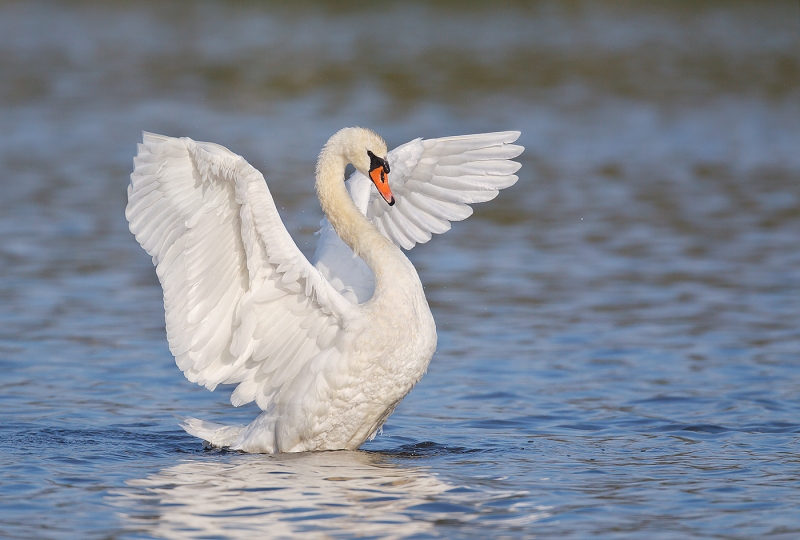|
This image of a Mute Swan flapping after a bath was created at the East Pond, Jamaica Bay Wildlife Refuge, Queens, NY with the tripod-mounted Canon 800mm f/5.6L IS lens and the EOS-1D Mark IV. ISO 400. Evaluative metering +2/3 stop: 1/2000 sec. at f/6.3. For a greater appreciation of the image above, click on the photo to view a larger version. Click on the enlarged version to close it. |
My Comments on: For Your Critique/Image #7
On September 14, 2011 I posted For Your Critique: Image #7. This one was entered in the Behaviour Birds category of the 2011 WPOTY competition. I like this image a lot, especially for its elegance. As the contest is UK based Mute Swan images often do well. Because I choose to remove distracting background elements from so many of my avian images, I cannot enter them in various contests. This one was pretty much straight out of camera but for dust-spotting, color & contrast adjustments, and sharpening.
Most folks offered positive comments. Some folks like the brown and blue bands in the water. Others did not. I would have preferred all blue without any ripples. (The brown was reflections of the phragmites, the giant reeds, on the far shoreline.) It was suggested that I eliminate the single, large drop of water from the spray in front of the bird. I would have liked to but that is not permitted under the WPOTY rules. (Click here for an interesting discussion on digital contest guidelines.) Some folks praised the exposure and the detail in the white feathers, others felt that the white feathers lacked detail. Two folks thought that the primaries of the near wing had been damaged or clipped; though this species is introduced in the US this was a free and wild bird. The primaries of the near wing are simply foreshortened. As fr the image design and the crop, I love it as is.
Note that in North America both Canada Goose and Mute Swan are often ignored as potential photographic subjects. Though I am not a fan of introduced species like Mute Swan, I do not hesitate to photograph them and use them as teaching aids both in the field and during Photoshop sessions. When you see either species dipping their breasts in the water, get ready to create some dramatic images as they will almost always rise up out of the water and flap for all they are worth. The same goes for most bird families especially shorebirds and ducks.
|
For those who prefer a bit more detail in the WHITEs, I ran NIK Color Efex Pro’s Detail Extractor at about 40% on the image and painted the effect in on the bird only with a Hide-all Mask (as described in detail in Digital Basics). For a greater appreciation of the detail in the WHITEs in the image above, click on the photo to view a larger version. Click on the enlarged version to close it. |
NIK Color Efex Pro 4 Recipe Tip
If missed my NIK Color EFEX Pro 4 Recipe Tutorial, click here.
You can see spectacular before and after Color Efex recipe images here.
NIK 15% Discount
You can save 15% on all NIK products by clicking here and entering BAA in the Promo Code box at check-out. Then hit Apply to see your savings. You can download a trial copy that will work for 15 days and allow you to create full sized images.
NIK Creative Efex Collection
NIK recently announced the availability of a special limited production bundle of 3 of their most popular products, Color Efex Pro 4, Silver Efex Pro 2, and HDR Efex Pro. You can save more than $200 on the bundle which is available only through NIK affiliates. If you would like additional info, please e-mail with the words “Creative Efex Collection” in the Subject line. If you have been on the fence about purchasing the plug-ins mentioned above this is a great chance to save some significant bucks.
Thanks to all who commented. Note: this image did not make the final round of judging.
Earn Free Contest Entries and Support both the Bulletins and the Blog by making all your B & H purchases here.
More and more folks are earning multiple contest entries with their B & H purchases. See here for details on that. Eleven great categories, 34 winning and honored images, and prize pools valued in excess of $20,000. Click here to visit the competition home page.
Shopper’s Guide
Below is a list of the gear used to create the image in today’s blog post. Thanks a stack to all who have used the Shopper’s Guide links to purchase their gear as a thank you for all the free information that we bring you on the Blog and in the Bulletins. Before you purchase anything be sure to check out the advice in our Shopper’s Guide.
Support both the Bulletins and the Blog by making all your B & H purchases here.
Remember: you can earn free contest entries with your B & H purchases. Eleven great categories, 34 winning and honored images, and prize pools valued in excess of $20,000. Click here for details.
Shopper’s Guide
Below is a list of the gear used to create the image in today’s blog post. Thanks a stack to all who have used the Shopper’s Guide links to purchase their gear as a thank you for all the free information that we bring you on the Blog and in the Bulletins. Before you purchase anything be sure to check out the advice in our Shopper’s Guide.
Canon 800mm f/5.L IS lens. Right now this is my all time favorite super-telephoto lens.
Canon EOS-1D Mark IV professional digital camera body. My two Mark IVs are my workhorse digital camera bodies.
And from the BAA On-line Store:
LensCoats. I have a LensCoat on each of my big lenses to protect them from nicks and thus increase their re-sales value. All my big lens LensCoat stuff is in Hardwood Snow pattern.
LegCoat Tripod Leg Covers. I have four tripods active and each has a Hardwood Snow LegCoat on it to help prevent further damage to my tender shoulders 🙂
Gitzo GT3530LS Tripod. This one will last you a lifetime.
Mongoose M3.6 Tripod Head. Right now this is the best tripod head around for use with lenses that weigh less than 9 pounds. For heavier lenses, check out the Wimberley V2 head.
CR-80 Replacement Foot for Canon 800. When using the 800 on a Mongoose as I do, replacing the lens foot with this accessory lets the lens sit like a dog whether pointed up or down and prevents wind-blown spinning of your lens on breezy days by centering the lens directly over the tripod.
Double Bubble Level. You will find one in my camera’s hot shoe whenever I am not using flash.
Be sure to check out our camera body User’s Guides here.
The Lens Align Mark II. I use the Lens Align Mark II pretty much religiously to micro-adjust all of my gear an average of once a month and always before a major trip. Enjoy our free comprehensive tutorial here.
Canon EOS-1D Mark IV User’s Guide. Learn to use your Mark IV the way that I use mine. Also available for the 7D and the Mark III here.

















I still can’t help but like it. On second viewing it’s even better. And yes, the appearance of the near primaries is deceptive, but zoomed in it’s easy to spot the curvature of the feather tips, and on four of them we are actually seeing the back of the feather.
I find it very difficult to believe the wing feathers on the near side of the birds wing were not clipped. As you look at the acute angle of the feathers on the near wing they do not relate to the rounded feathers on the other wing and believe this is an escaped bird but nicely photograph especially the detail in the white feathers.
Hi Alan, Believe it. If you look closely, you can see that the near primary tips are simply curled towards us. The bird is a free and wild, un-pinioned bird (though it is an introduced species). artie